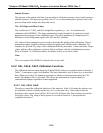
Teledyne API Model 200AU NO
X
Analyzer Instruction Manual, 02293, Rev. F
5-18
The function of each of the default Data Channels is described below:
CONC:
Samples NO
x
, NO and NO
y
concentration data at one minute intervals and
stores an average every hour with a time and date stamp. Readings during
calibration and calibration hold off are not included in the data. The last 800
hourly averages are stored.
PNUMTC:
Collects sample flow and sample pressure data at five minute intervals and
stores an average once a day with a time and date stamp. This data is useful for
monitoring the condition of the pump and critical flow orifice(sample flow) and
the sample filter(clogging indicated by a drop in sample pressure) over time to
predict when maintenance will be required. The last 360 daily averages (about 1
year) are stored.
CALDAT:
Logs new slope and offset every time a zero or span calibration is performed,
also records the sample concentration reading just prior to performing a
calibration.
STABIL:
Logs the standard deviation of the last 50 minutes of NO
x
data, with readings
taken 2 minutes apart(i.e. 25 readings taken 2 minutes apart.) The collector
operates in “sliding window” fashion with the oldest reading being deleted and
a new reading added every 2 minutes. A new value of STABIL is added to the
data buffer every 2 minutes. A time and date stamp is recorded for every data
point logged.
NOTE:
This Data Channel collects data based on an event (a calibration) rather than a
timer. This Data Channel will store data from the last 200 calibrations. This
does not represent any specific length of time since it is dependent on how often
calibrations are performed. As with all Data Channels, a time and date stamp is
recorded for every data point logged.
This is the EPA definition of noise used for equivalency testing. The collector provides a
continuous readout of the noise. In order for the data to be meaningful, the instrument must
sample a constant concentration of gas for at least 50 minutes.


















